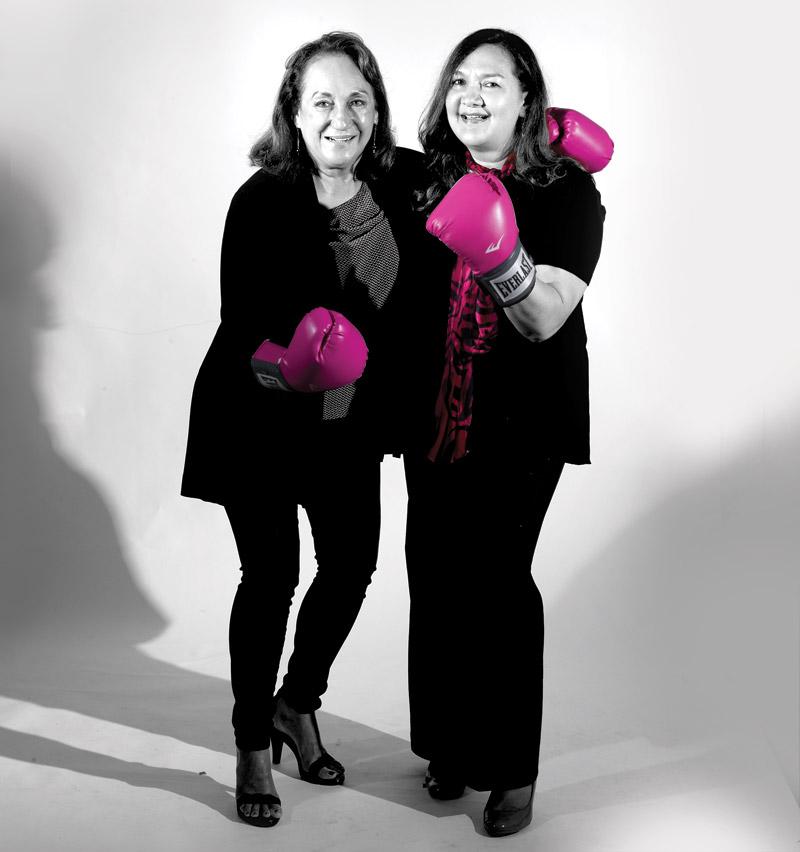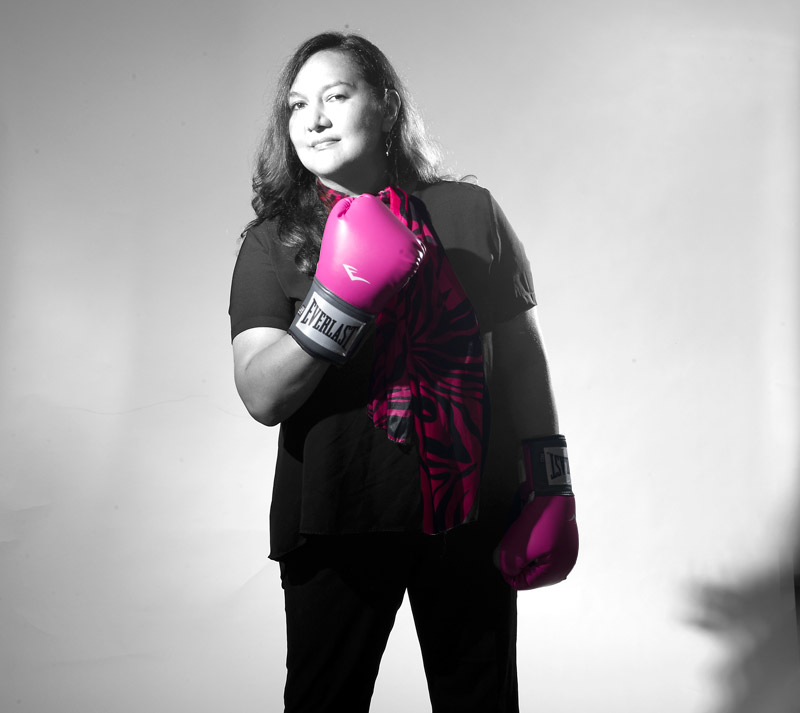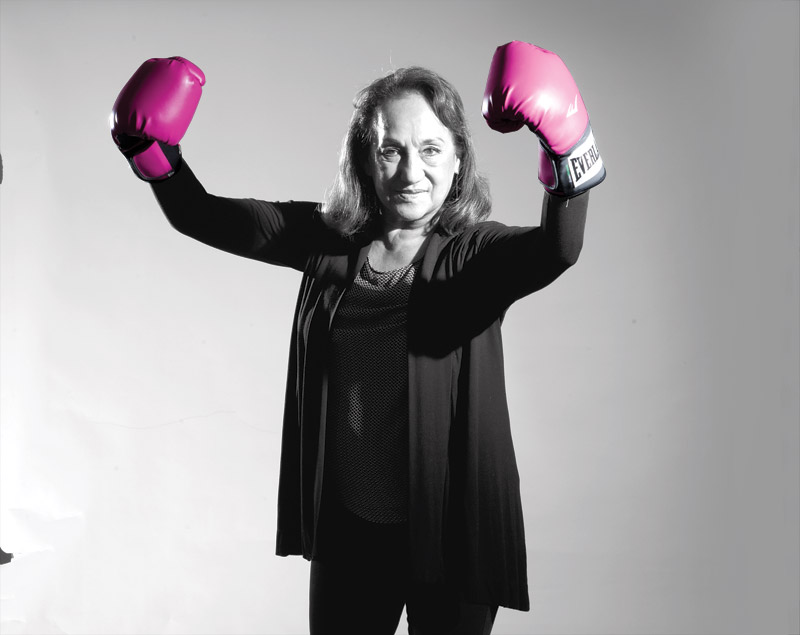The Main Event For Cure

Vicky Holt Takamine (left), honorary chair of this year’s Susan G. Komen Race for the Cure, and Amanda Stevens, executive director of Susan B. Komen Hawai‘i, get ready to rumble.
The fight to KO breast cancer continues next month when thousands participate in the Susan G. Komen Race for the Cure at Kapiolani Park.
Vicky Holt Takamine has a brazen rallying cry.
“Check your chichis,” she urges women everywhere. Her language might be direct and colloquial, but the message is as serious as it gets.
Just ask the one in eight women, like Takamine, who is diagnosed with breast cancer. Detection and treatment are sparring events that take a toll on one’s health.
A local kumu hula and cultural activist, Takamine is honorary chair of this year’s Susan G. Komen Race for the Cure. The 23rd annual event takes place Sunday, Oct. 15, at Kapi‘olani Park, with 5,000 people expected.
“Since its inception, Komen Hawai‘i has funded $4 million for breast cancer education, screenings, treatment and survivor support programs throughout the state,” says Amanda Stevens, executive director of Susan G. Komen Hawai‘i. “Seventy-five percent of the funds stays in Hawai‘i for breast health programs, while 25 percent supports breast cancer research,” she states.
Those are significant numbers when one considers the bold mission of Komen to reduce breast cancer mortality by 50 percent by 2026. To accomplish that in a decade would be stunning.

Amanda Stevens
Stevens joined Komen Hawai‘i in 2015 after working many years as a consultant for nonprofit organizations and heading major grants and gifts for The Queen’s Medical Center.
More Than Pink “It will take a one-two punch of awareness and advocacy,” asserts Stevens, who leads Komen Hawai‘i’s bout to be “more than pink.”
Komen’s pink ribbons and color theme are well known in public service campaigns.
Stevens and race chair Takamine are Hawai‘i’s champions for the cure. You can’t find two tougher challengers for the counterpunch against breast cancer. While awareness is addressed with year-round communications, action is the new priority sought for health-conscious islanders and supporters.
Takamine’s personal story and plight to battle cancer is nothing short of forthright and inspiring.
“Both my mother and grandmother had breast cancer,” she says. “My mother went through lumpectomy, chemotherapy and radiation. My sister died of lymphoma in her 40s.
“Even with this family history, I never thought about it,” Takamine adds. “I was very healthy, yet I knew there was a risk.”
Biopsy Bout Two years ago, Taka-mine noticed a lump on her breast, even while having routine mammograms declared clear. She was conscious of it, so doctors ordered a biopsy.

Vicky Holt Takaminea
“It came back positive — invasive carcinoma,” she says. “I should not have taken the first report at face value, knowing I had a lump.
“You must be an advocate for your own health.”
Given the options for treatment and considering her busy lifestyle, Takamine, 70, chose to have a mastectomy (breast removal surgery). In fact, she courageously chose a double mastectomy to address the risk of cancer spreading to the other side.
Life has a way of teaching lessons through mounting crises. That’s the way it was with Takamine.
“My diagnosis came days before my father died,” she says. “I needed to take care of that kuleana (responsibility) first.
“I also had trips planned to Chicago and Mississippi the following week,” she recounts.
The kumu hula was being honored with a USA Doris Duke fellowship, selected from over 500 nominated artists for innovation and accomplishment in her field.
Takamine’s diagnosis was certainly an untimely occurrence, given her personal and professional demands.
Cancer can enter the ring of life at any time and is indiscriminate about who (woman or man) and when it shows up for the fight. It pulls no punches.
Come Out Fighting But like Takamine and other cancer victims and survivors, one cannot simply throw in the towel. When life rings a bell, it’s time to come out and fight.
“It’s about quality of life,” Stevens says. “That is particularly so in Hawai‘i, where residents come from diverse cultural backgrounds and openly discussing health problems is discouraged. Certain ethnic groups even shun the use of the word ‘breast’ in polite dialogue. So Komen has had to change how people talk about the issue.”
Yet one cannot cower in ignorance. Komen encourages getting as much information as necessary about one’s situation so prudent and pro-active choices are made for treatment and recovery.
Komen Hawai‘i, headquartered at 3555 Harding Ave. in Kaimukī and found on the internet at komenhawaii.org, provides information and guidance on many facets of the subject.
It’s an inspired mission that began 35 years ago as a promise between Nancy G. Brinker and her dying sister, Susan. In 1982, the Susan G. Komen organization began a global movement to become the largest nonprofit source of funding for the fight against breast cancer.
To date, more than $2.9 billion has been invested in groundbreaking research, community health outreach, advocacy and programs in more than 60 countries.
Breast cancer is the most commonly diagnosed cancer in women. It is the second leading cause of cancer death among women.
Although breast cancer in men is rare, an estimated 2,600 men are diagnosed with breast cancer and approximately 440 die each year, according to national health statistics.
On Your Mark The Susan G. Komen Race for the Cure is the world’s largest, most successful fundraising and education event for breast cancer. Hawai‘i’s event is organized by Komen Hawai‘i’s staff of three supported by a dedicated board, race committee and hundreds of volunteers.
The Oct. 15 occasion includes a 5K or 1-mile fun walk/run, live entertainment, expo, keiki zone, survivors tent, team village and vendor booths. Taka-mine’s hālau presents the opening oli and chants for the ceremonies.
“We all know people who have battled cancer,” Takamine says. “This cause is important because it saves lives.”
The outspoken activist, who is in the breast reconstruction phase of her treatment, speaks frankly and openly about her journey. She once revealed her plight to audiences at the annual MAMo Wearable Art fashion show she co-hosts with
fellow kumu hula and entertainer Robert Cazimero.
“It was a captive audience, so I took the opportunity to encourage folks to look after their health and check their chichis,” she recalls.
“It’s the first time I’ve seen Robert speechless!” she exclaims with a laugh.
But speaking out is only one facet of her determination to support Komen and get folks to be advocates of their health care.
“If we’re not healthy, we can’t help others,” she states. “Each case and cancer journey is different, so the best we can do is to plan a course that’s right for us.
“I was fortunate to have a patient navigator who guided me through each step of my treatment and recovery.
“Now it’s time for me to give back to others in the same fight,” she adds.
One such gesture is that Takamine offers two months of free hula therapy at her Pua Ali‘i ‘Ilima studio to breast cancer survivors wanting to improve mobility and range of motion in limbs.
“Put that in the story,” she directs this writer.
Done, Aunty Vicky.
Registration and donation forms for Komen Hawai‘i’s Race for the Cure can be found at komenhawaii.org
Terminology can be as intimidating as the diagnosis of cancer. Here are common words used in the discussion of cancer.
voCANCERlary
Biopsy: The removal of a small amount of tissue for examination under a microscope. Other tests can suggest that cancer is present, but only a biopsy can make a definite diagnosis.
Cancer: Begins when healthy cells in the breast change and grow out of control, forming a mass or sheet of cells called a tumor. A tumor can be cancerous or benign. A cancerous tumor is malignant, meaning it can grow and spread to other parts of the body. A benign tumor means that the tumor can grow but will not spread.
Carcinoma: Cancer that starts in skin or tissues that line the inside or cover the outside of internal organs.
Chemotherapy: The use of drugs to kill cancer cells.
Lymphoma: A cancer of the lymphatic system. Lymphoma begins when cells in the lymphatic system change and grow uncontrollably. Sometimes a tumor is formed.
Lumpectomy: A surgery intended to remove only the tumor and a small amount of surrounding normal issue. A lumpectomy is a form of “breast conserving surgery.”
Mammogram: An X-ray of the soft tissue of the breast.
Mastectomy: Surgical procedures to remove the breast.
Radiation: The use of X-ray energy to kill cancer cells.






